James Webb Space Telescope Discovery
Clicking on each image will open the full resolution one. Try it!Clicking on "Raw images" image will yield all the relevant raw images.
Cassiopeia A: NASA Telescopes Chase Down "Green Monster" in Star's Debris
• Astronomers have used Chandra and Webb data to help solve the mystery of the "Green Monster" near the center of the Cas A supernova remnant.
• The Green Monster was first spotted in Webb data in April 2023, while Chandra has observed Cas A for decades.
• Chandra data reveals hot gas, mostly from supernova debris, but also a blast wave from the supernova explosion.
• The combined data suggests that the Green Monster came from that blast wave slamming into material surrounding the supernova.
For the first time astronomers have combined data from NASA’s Chandra X-ray Observatory and James Webb Space Telescope to study the well-known supernova remnant Cassiopeia A (Cas A). As described in our latest press release, this work has helped explain an unusual structure in the debris from the destroyed star called the “Green Monster”, first discovered in Webb data in April 2023. The research has also uncovered new details about the explosion that created Cas A about 340 years ago, from Earth’s perspective.
A new composite image contains X-rays from Chandra (blue), infrared data from Webb (red, green, blue), and optical data from Hubble (red and white). The outer parts of the image also include infrared data from NASA’s Spitzer Space Telescope (red, green and blue). The outline of the Green Monster can be seen by mousing over the image.
The Chandra data reveals hot gas, mostly from supernova debris from the destroyed star, including elements like silicon and iron. In the outer parts of Cas A the expanding blast wave is striking surrounding gas that was ejected by the star before the explosion. The X-rays are produced by energetic electrons spiraling around magnetic field lines in the blast wave. These electrons light up as thin arcs in the outer regions of Cas A, and in parts of the interior. Webb highlights infrared emission from dust that is warmed up because it is embedded in the hot gas seen by Chandra, and from much cooler supernova debris. The Hubble data shows stars in the field.
A separate graphic shows a color Chandra image, where red shows iron and magnesium at low X-ray energies, green shows silicon at intermediate X-ray energies and blue shows the highest energy X-rays, from electrons spiraling around magnetic field lines. An outline of the Green Monster, plus the locations of the blast wave, and of debris rich in silicon and iron are labeled.
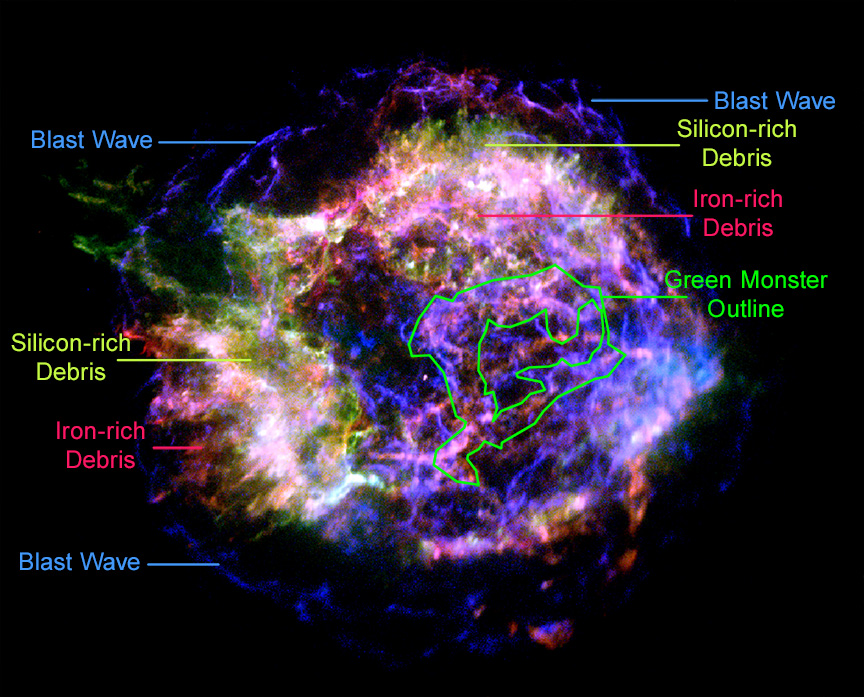 Chandra Image of Cassiopeia A, Labeled
Detailed analysis by the researchers found that filaments in the outer part of Cas A, from the blast wave, closely matched the X-ray properties of the Green Monster, including less iron and silicon than in the supernova debris. This interpretation is apparent from the color Chandra image, which shows that the colors inside the Green Monster’s outline best match with the colors of the blast wave rather than the debris with iron and silicon. The authors conclude that the Green Monster was created by a blast wave from the exploded star slamming into material surrounding it, supporting earlier suggestions from the Webb data alone.
The debris from the explosion is seen by Chandra because it is heated to tens of millions of degrees by shock waves, akin to sonic booms from a supersonic plane. Webb can see some material that has not been affected by shock waves, what can be called “pristine” debris.
To learn more about the supernova explosion, the team compared the Webb view of the pristine debris with X-ray maps of radioactive elements that were created in the supernova. They used NASA’s Nuclear Spectroscopic Telescope Array (NuSTAR) data to map radioactive titanium — still visible today — and Chandra to map where radioactive nickel was by measuring the locations of iron. Radioactive nickel decays to form iron. An additional image shows the iron-rich debris (tracing where radioactive nickel was located) in green, the radioactive titanium in blue and the pristine debris seen in orange and yellow.
Chandra Image of Cassiopeia A, Labeled
Detailed analysis by the researchers found that filaments in the outer part of Cas A, from the blast wave, closely matched the X-ray properties of the Green Monster, including less iron and silicon than in the supernova debris. This interpretation is apparent from the color Chandra image, which shows that the colors inside the Green Monster’s outline best match with the colors of the blast wave rather than the debris with iron and silicon. The authors conclude that the Green Monster was created by a blast wave from the exploded star slamming into material surrounding it, supporting earlier suggestions from the Webb data alone.
The debris from the explosion is seen by Chandra because it is heated to tens of millions of degrees by shock waves, akin to sonic booms from a supersonic plane. Webb can see some material that has not been affected by shock waves, what can be called “pristine” debris.
To learn more about the supernova explosion, the team compared the Webb view of the pristine debris with X-ray maps of radioactive elements that were created in the supernova. They used NASA’s Nuclear Spectroscopic Telescope Array (NuSTAR) data to map radioactive titanium — still visible today — and Chandra to map where radioactive nickel was by measuring the locations of iron. Radioactive nickel decays to form iron. An additional image shows the iron-rich debris (tracing where radioactive nickel was located) in green, the radioactive titanium in blue and the pristine debris seen in orange and yellow.
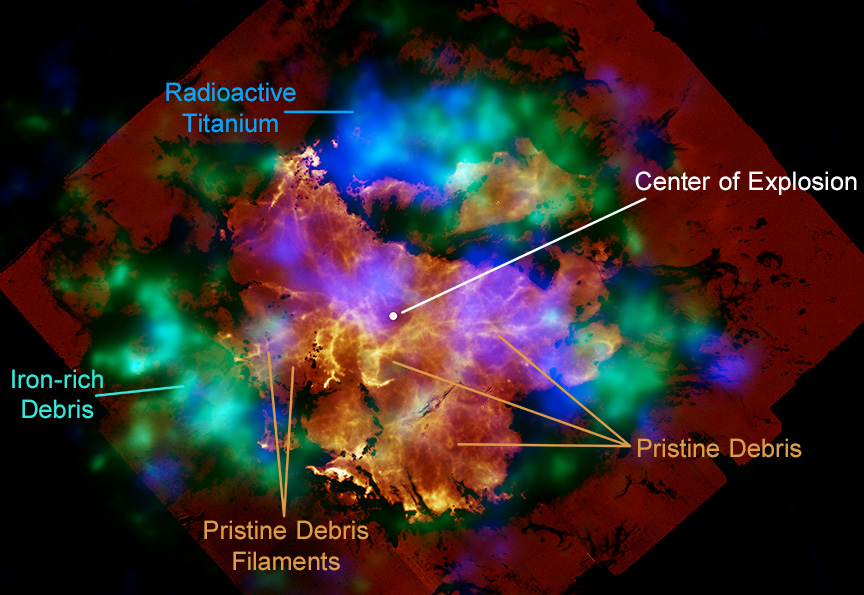 Iron/Titanium/Pristine Debris Cassiopeia A, Labeled
Some filaments of pristine debris near the center of Cas A, seen with Webb, are connected to the iron seen with Chandra farther out. Radioactive titanium is seen where pristine debris is relatively weak.
These comparisons suggest that radioactive material seen in X-rays has helped shape the pristine debris near the center of the remnant seen with Webb, forming cavities. The fine structures in the pristine debris were most likely formed when the star’s inner layers were violently mixed with hot, radioactive matter produced during collapse of the star’s core under gravity.
Credit: NASA/Chandra, X-ray: NASA/CXC/SAO; Optical: NASA/ESA/STScI; IR: NASA/ESA/CSA/STScI/Milisavljevic et al., NASA/JPL/CalTech; Image Processing: NASA/CXC/SAO/J. Schmidt and K. Arcand
Iron/Titanium/Pristine Debris Cassiopeia A, Labeled
Some filaments of pristine debris near the center of Cas A, seen with Webb, are connected to the iron seen with Chandra farther out. Radioactive titanium is seen where pristine debris is relatively weak.
These comparisons suggest that radioactive material seen in X-rays has helped shape the pristine debris near the center of the remnant seen with Webb, forming cavities. The fine structures in the pristine debris were most likely formed when the star’s inner layers were violently mixed with hot, radioactive matter produced during collapse of the star’s core under gravity.
Credit: NASA/Chandra, X-ray: NASA/CXC/SAO; Optical: NASA/ESA/STScI; IR: NASA/ESA/CSA/STScI/Milisavljevic et al., NASA/JPL/CalTech; Image Processing: NASA/CXC/SAO/J. Schmidt and K. Arcand
 Composite
Composite
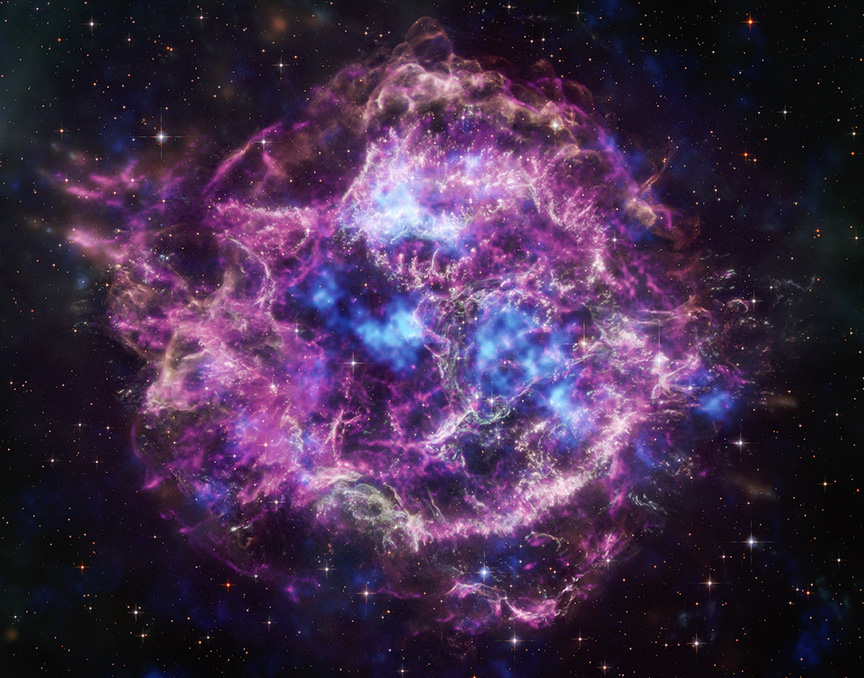 Composite (elements)
Composite (elements)
 X-ray Chandra
X-ray Chandra
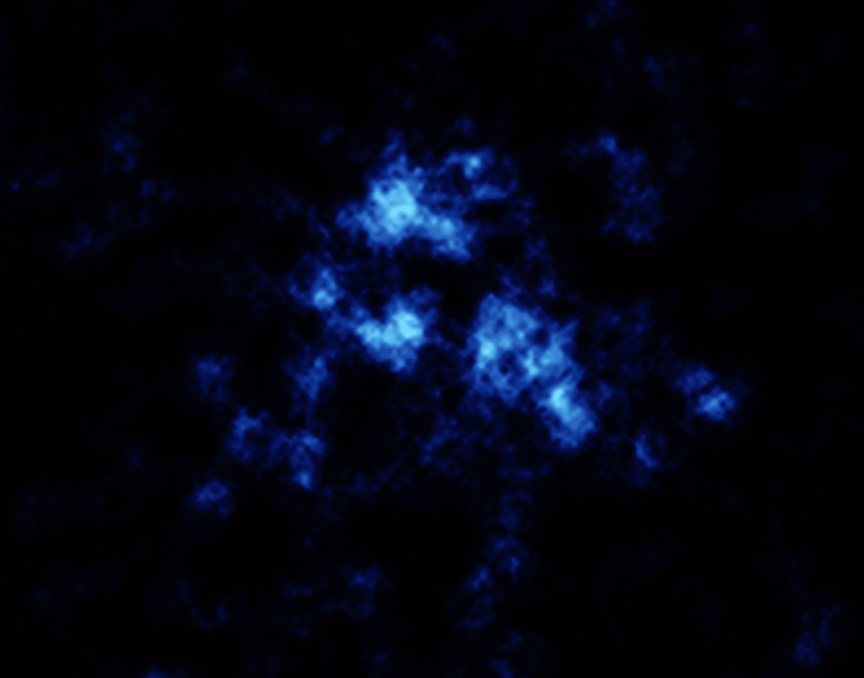 X-ray NuSTAR
X-ray NuSTAR
 Optical
Optical
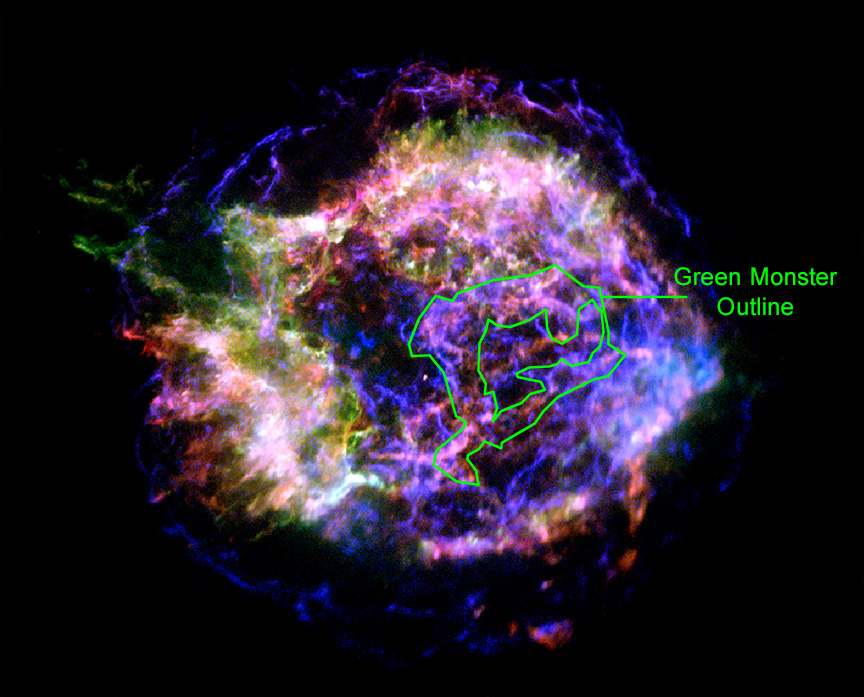 X-ray "Green Monster" Labeled Chandra
X-ray "Green Monster" Labeled Chandra
Quick Look: NASA Telescopes Chase Down "Green Monster" in Star's Debris
 Cas A (NIRCam) discovery page
Cas A (NIRCam) discovery page